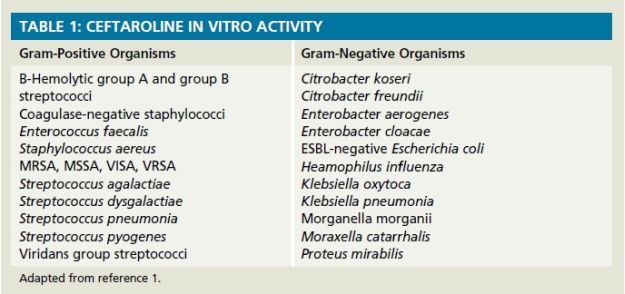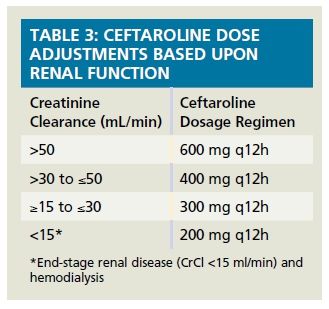Publication
Article
Pharmacy Practice in Focus: Health Systems
Ceftaroline (Teflaro)
Author(s):
FDA approved for the treatment of community-acquired pneumonia, ceftaroline is the first 5th-generation cephalosporin.

Background
Ceftaroline (Teflaro), manufactured by Forest Pharmaceuticals, is FDA approved for the treatment of community-acquired pneumonia (CAP) and acute bacterial skin and skin structure infections (ABSSSIs) caused by susceptible isolates of Gram-negative and Gram-positive bacteria, including methicillin-resistant Staphylococcus aureus (MRSA). Ceftaroline is the first “5th-generation cephalosporin” and has a broader Gram-positive spectrum of activity than all other cephalosporins due to its activity against MRSA.
Ceftaroline fosamil is a beta-lactam antibiotic and the prodrug of ceftaroline. Similar to all other beta-lactam antibiotics, ceftaroline inhibits bacterial cell wall synthesis through binding to penicillin-binding proteins (PBPs). Ceftaroline’s affinity for PBP2a and PBP2x results in its bactericidal activity against MRSA and Streptococcus pneumoniae, respectively. Ceftaroline does not exhibit activity against Acinetobacter species and possesses minimal activity against Pseudomonas aeruginosa. Ceftaroline is also not effective against Gram-negative bacteria that produce extended-spectrum beta-lactamases (ESBLs), including carbapenemases, class B metallo-beta-lactamases, and AmpC cephalosporinases. According to the package insert, ceftaroline possesses in vitro antimicrobial activity (as detailed in Table 1).1,2

Pharmacokinetics
The pharmacokinetics of ceftaroline following single and multiple infusions of 600 mg every 12 hours for 14 days in healthy adults with normal renal function are summarized in Table 2.1,2 The median volume of distribution of ceftaroline at steady state is 20.3 L or 0.37 L/kg; plasma protein binding of ceftaroline is approximately 20%. Ceftaroline fosamil is rapidly converted in the plasma by phosphatases to the active form, ceftaroline; ceftaroline is not a substrate for CYP450 enzymes.1 Ceftaroline is primarily renally eliminated, with 88% of an administered dose recovered from urine and 6% from feces. The elimination half-life of ceftaroline is 2.6 hours.1-3

Dosing
The dose of ceftaroline is 600 mg administered intravenously every 12 hours and infused over 60 minutes in patients ≥18 years of age. The recommended duration of therapy of ceftaroline in ABSSSIs is 5 to 14 days while that for CAP is 5 to 7 days. Although not an approved route of administration, there are data to support administration of ceftaroline via the intramuscular route in patients without IV access. Dosing regimens have not been established for pediatric patients. Dose adjustments of ceftaroline in elderly patients should be based upon renal function.
Dosage adjustment of ceftaroline is required for patients with a creatinine clearance of <50 mL/ min. Ceftaroline is hemodialyzable; 21.6% of a single 400-mg ceftaroline dose is removed by a 4-hour dialysis session. Ceftaroline should be administered following hemodialysis on dialysis days. Ceftaroline dose adjustments based on renal function are described in Table 3.1-4

Clinical Efficacy
Ceftaroline has been studied in humans for the treatment of CAP and ABSSSIs. There have been 4 Phase 3 studies; 2 studies evaluated the safety and efficacy of ceftaroline versus vancomycin in skin and skin-structure infections (CANVAS 1 and 2), and 2 studies evaluated the safety and efficacy of ceftaroline versus ceftriaxone in community-acquired pneumonia (FOCUS 1 and 2). The studies demonstrated noninferiority of ceftaroline compared with vancomycin in the treatment of acute bacterial skin and skin structure infections (CANVAS) as well as noninferiority when compared with ceftriaxone in the treatment of community-acquired bacterial pneumonia (FOCUS).2-5
Medication Safety
Ceftaroline is well tolerated and has an adverse effect profile similar to that of other cephalosporins. The most common adverse events reported in clinical trials include diarrhea, nausea, and headache; however, ceftaroline has also rarely caused Clostridium difficile—associated diarrhea, direct Coombs test seroconversion, and QTc interval prolongation. Although there are no controlled trials of ceftaroline in pregnant women, the FDA has given ceftaroline a category B designation due to the lack of toxicity seen in animal studies. Compatibility studies of ceftaroline with other drugs are limited; therefore, ceftaroline should not be mixed with or physically added to solutions containing other drugs before reviewing compatibilities.1-3
Product Availability and Cost Considerations
The prodrug, ceftaroline fosamil, is available as 400- and 600-mg vials of powder for reconstitution. Vials must be kept refrigerated. Each vial must be reconstituted with 20 mL of Sterile Water for Injection, USP, resulting in 20 mg/mL and 30 mg/mL concentrations using the 400- and 600-mg vials, respectively.1 The final ceftaroline solution for infusion should be administered within 6 hours of preparation when stored at room temperature and within 24 hours when refrigerated at 2°C to 8°C (36°F to 46°F).1 The Average Wholesale Price (AWP) of ceftaroline (Teflaro) is $49 per vial (both 400 and 600 mg). Health care professionals can access more information about ceftaroline, including complete prescribing information, at www.teflaro.com.1,2
References
1. Teflaro [package insert]. St. Louis, MO: Forest Pharmaceuticals, Inc; February 2011.
2. Ceftaroline (Drug Evaluation). In: DrugDex editorial staff: DRUGDEX System. Thompson Micromedex, Greenwood Village, Colorado.
3. Steed M, Rybak M. Ceftaroline: a new cephalosporin with activity against resistant gram-positive pathogens. Pharmacotherapy. 2010;30(4):375-893.
4. Saravolatz L, Stein G, Johnson L. Ceftaroline: a novel cephalosporin with activity against methicillin-resistant Staphylococcus aureus. Clin Infect Dis. 2011;52(9):1156-1163.
5. Laudano J. Ceftaroline fosamil: a new broad-spectrum cephalosporin. J Antimicrob Chemother. 2011;66(suppl 3):iii11-iii18.
Ashley N. Lewis, PharmD, BCPS, is a drug information specialist at University of North Carolina Hospitals (UNCH). She completed her pharmacy training at Virginia Commonwealth University and went on to complete a general pharmacy practice residency followed by a drug information specialty residency at the Medical University of South Carolina. She is currently the pharmacy and therapeutics secretary at UNCH, and manages the day-to-day operations of the Drug Information Center and serves as a clinical assistant professor at the UNC Eshelman School of Pharmacy.







